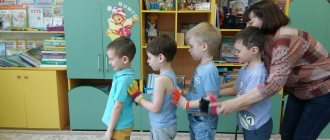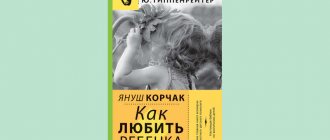Strategic goal of the subsidiary
The strategic goal of preschool education is to develop the child’s life competence, directing it towards creativity and self-realization.
The leading activity of preschool children is play. In order to provide preschool education to all children of preschool age, especially children of five years of age, the Program can also be used to work with children in short-term preschool educational institutions, general education institutions, out-of-school educational institutions, and development centers.
Children's mastery and experience of various types and forms of activities planned in block-thematic cycles ensures the systematic formation of children's ideas and knowledge, thanks to a holistic perception of the topic.
Such planning and the entire program of activities in kindergarten allows the teacher to build the educational process in such a way as to maximally realize the stated goal, the key idea through a system of classes, appropriate forms and methods of teaching, optimal for each age group.
The system of educational work on the topic is presented holistically in the proposed form of a long-term plan. Daily planning is drawn up on the principle of a methodological constructor, the elements of which during the day can be transformed, change sequence, etc., depending on the real situation.
Combined classes
Unlike an integrated lesson, a combined lesson consists of separate parts that are not interconnected and have their own program tasks from one or different divisions of the Program (language teaching and speech development with the environment, physical education, visual arts, fiction).
An important form of teaching elements of literacy to children of senior preschool age are organized classes (group, individual-group, individual).
We advise you to plan once a week group or individual group lessons to teach children the elements of literacy in the senior group, and plan and conduct individual lessons every day with individual children, taking into account their individual characteristics.
We remind you that it is advisable to teach children the elements of literacy and preparation for writing with small groups of children or as group work for children of the sixth and seventh years of life who identify the need to read and write.
Teaching preschoolers the elements of literacy
As the practice of modern preschool educational institutions shows, it is advisable to teach elements of literacy to children of senior preschool age with small groups of children, so group (up to 15 people), individual-group (4-8 people) and individual (1-4 people) will prevail. classes that bring together children of senior preschool age of approximately the same level of development (if children have different levels of development, then separate tasks should be planned for such children).
It’s no secret that among kids there are those who are already interested in sounds and letters or even read words, sentences and the like on their own. We recommend involving such children in group work.
In classes on teaching elements of literacy, which are advisable to be held once a week as a group or individually, children listen to speech, learn that it consists of sentences, sentences are built from words, and words can be divided into syllables and individual sounds.
Basics of the program
The program is based on the concept of psychological age as a stage, a stage of child development, characterized by its structure and dynamics.
So, each psychological age includes:
- qualitatively special, specific relationships between a child and an adult (“Creation of the “I Want” Foundation”), that is, introducing the child to the system of values developed by humanity, organizing conditions for her spiritual growth, forming the foundations of a value-based attitude to reality;
- a certain hierarchy of activities and their leading types (“Creation of the “I Can” Foundation”), that is, the child’s assimilation of knowledge, mastery of skills, the formation of a culture of knowledge, the ability to independently practically use what has been acquired in life;
- the main psychological achievements of the child, indicating the development of his psyche, self-awareness, personality (“Indicators of the child’s competence”), that is, a mandatory minimum set of basic knowledge, ideas, practical skills and abilities that guarantee the child’s adaptation to life, the ability to navigate in it, adequately react to phenomena, events, people.
Indicators of a child’s competence are the minimum educational core, the level of assimilation of which is reflected in the qualitative and quantitative indicators of the child’s activity and behavior.
Activities program in kindergarten “Child”
The activity program in kindergarten “Child” offers an integrative approach to organizing the educational process.
But, unfortunately, the authors of the program did not provide an approximate distribution of either subject or integrated classes for a week or a month.
This information can be extracted from some sections of the methodological recommendations for the program. For example, on speech development, it is recommended to conduct 4 classes per month: 3 comprehensive and 1 special (dominant).
Speech classes are recommended for all age groups once a week only with groups of children (up to 15 people).
If there are 20 or more children in a group, then it is advisable to divide them into 2 or more subgroups.
Distribution of complex and special speech classes during the month and quarter
| Month of the quarter | Type of speech lesson and components of program content | |||
| 1 Week | 2 week | 3 week | 4 week | |
| I | Complex: | Complex: | Complex: | Special (thematic): |
| 1. Coherent speech | 1. Coherent speech | 1. Coherent speech | Sound culture of speech | |
| 2. Grammar | 2. Dictionary | 2. Grammar | ||
| 3. Dictionary | 3. Sound culture of speech | 3. Sound culture of speech | ||
| II | Complex: | Complex: | Complex: | Special (thematic): |
| 1. Coherent speech | 1. Coherent speech | 1. Coherent speech | 1. Grammar | |
| 2. Grammar | 2. Dictionary | 2. Grammar | ||
| 3. Dictionary | 3. Sound culture of speech | 3. Sound culture of speech | ||
| III | Complex: | Complex: | Complex: | Special (thematic): |
| 1. Coherent speech | 1. Coherent speech | 1. Coherent speech | 1. Dictionary | |
| 2. Grammar | 2. Dictionary | 2. Grammar | ||
| 3. Dictionary | 3. Sound culture of speech | 3. Sound culture of speech | ||
In a preschool institution, in all age groups, integrated classes should be conducted, which combine several areas of children’s activities, and combined classes in order to consolidate the knowledge, speech and skills acquired by children.
Fiction classes
Classes in fiction are held in all age groups: frontal or group lessons at least once a week, individual, individual-group - almost daily.
In the system of educational work of mathematical content, it is necessary to provide for integrated, complex classes.
For example: a combination of mathematics classes with other types of activities - construction, visual arts, physical education, excursions into nature.
Physical education and music classes are planned twice a week.
In autumn, winter and spring, two physical education classes are held in the gym, and three are held outdoors.
| Forms of work | Features of organizing classes | Group | Duration, in minutes |
| Physical education classes | daily | younger | 20-25 |
| average | 25-30 | ||
| older | 30-35 | ||
| preparatory | 35-40 |
An approximate diagram of the calendar planning of the teacher’s educational work for the main routine moments of the first and second half of the day
| The first half of the day | Afternoon | |||
| Morning | Classes | Walk | Labor, independent artistic activity | Entertainment, games |
| Games, conversations, observations, work, individual work with children and parents; independent motor activity of children | Subject. Program content. Material. Plan (course) of the lesson. | Games, work, observations, sports games and exercises, individual work in various sections of the program, excursions, walks. trips outside the kindergarten, independent motor activity of children | Different types of labor (manual, household, outdoor) in different forms. independent artistic activities of children (visual, artistic and design, speech, musical, theatrical) | Various types of theaters (puppet, shadow, toys, etc.), dramatization games, performances, concerts, physical education, musical, literary leisure |
In the second half of the day, you can also schedule the activities of the clubs according to the plans of the leaders of the clubs.
Approximate diagram of calendar planning of educational work of a teacher by types of children's activities and forms of work of a teacher with children
| Play activity | Various types of games: plot-role-playing, construction-constructive, dramatization, didactic and the like. |
| Educational and cognitive activity | Classes (topic, program content, material, course of the lesson) |
| Labor activity | Various types and forms of labor |
| Communication activities | Individual, group, collective conversations with children on personal, moral and ethical topics, organization and acting out of interpersonal communication situations, etc. |
| Cognitive activity | Observations, targeted walks, excursions, children's experimentation, experiments, reading fiction, etc. |
| Motor activity | Outdoor games, elements of sports games and exercises, physical education holidays and entertainment; walks outside the kindergarten, independent motor activity of children |
| Club work | Topics of circle classes according to the plans of the circle leaders |
| Individual work with children and parents | Individual work with children in various sections of the program (games, exercises, conversations, conversations and other forms), individual conversations, conversations, consultations for parents |
Features of using the “Child in preschool years” program
The activity program in kindergarten “Child in the preschool years” is a new type of program.
The program is focused on the values and interests of the child, taking into account age-related capabilities, preserving the children's subculture, amplifying child development, and the interconnection of all aspects of the child's life.
The program of activities in kindergarten “Child in the preschool years” is addressed to teachers, practical psychologists and social teachers of preschool educational institutions, educators who work in family-type homes and boarding schools; students of pedagogical universities and colleges studying in the specialty “Preschool Education”, parents.
The goal of the program is to ensure the full physical, social, cognitive and aesthetic development of the personality of a child of the sixth year of life; to facilitate entry into the Universe and develop his internal strengths and spiritual potential.
The main objectives of the program are to equip the child with the science of life:
- formation of basic characteristics;
- ensuring a “one start” opportunity for six-year-old children;
- creation of a unified educational environment, which promotes prospects and continuity between preschool educational institutions and primary schools.
The scientific and theoretical foundation of the program is the achievements of domestic and world psychological and pedagogical science, as well as modern studies of child development, which recognize the originality, uniqueness, peculiarity of preschool childhood in the development of personality, taking into account the sensitivity of this period regarding the formation of the primary schematic worldview, subordination of motives, voluntary behavior , internal ethical authorities, self-awareness.
Technology for constructing an educational space
The technology for constructing an educational space using a methodological constructor provides a wide field of professional freedoms for educators within a given thematic cycle.
Such freedom gives him the opportunity to independently construct a general picture of the day and even the week from individual didactic elements (effective forms, methods, means of teaching and raising children) available in the file cabinet.
Criteria for selecting didactic elements
In this case, the main criteria for choosing the appropriate didactic element are:
- personal vision, understanding and acceptance by the teacher of each educational topic;
- focusing on the capabilities, interests and inclinations of children of a particular group;
- accounting of available resources.
The advantage of planning according to the principle of a methodological designer lies, firstly, in a high degree of trust in the professional skills of the teacher, who is able to build his work with children, focusing on the feelings of the real situation, and not according to generalized standardized regulations.
Secondly, minimizing the amount of necessary documentation for daily planning significantly saves the teacher’s time and effort. That is, the teacher, from a prepared card index the day before or at the beginning of the day, selects for himself those didactic tools that he needs to work on the train of the day. This means that he does not waste precious time copying into a journal for scheduling all types of work, to which life will still make its own adjustments.
While working with children, the teacher reflects, listens with his heart and mind to himself and his students and, using the card index of the methodological designer, optimally organizes the educational process.
We note that this technology requires further development regarding practical application and, in accordance with this, at the initiative of the Ministry of Education and Science, a series of publications “Library of a Preschool Teacher” has been developed as didactic and methodological support for the Basic Component of Preschool Education.
These materials can also be used in the educational process using this technology.
Experienced teachers will discover new opportunities for creative professional self-expression in this didactic and methodological support.
And young educators will find tips on how to organize educational work during the day. the most interesting and useful for children.
Program structure
The program has features in its structure and consists of two parts: a program of activities in kindergarten for early and pre-school age and activities in kindergarten for preschool children.
Section “Gender Socialization”
The subsection “Gender Socialization” was developed in accordance with the latest research by psychologists. It covers two interrelated aspects:
- the preschooler’s assignment of accepted models of male and female behavior, relationships, norms, values and gender stereotypes;
- the influence of society and the social environment on an individual with the aim of instilling in him certain rules and standards of behavior that are socially acceptable for men and women.
Rhetoric
New to the program is the “Rhetoric” direction. The program of activities in kindergarten assigns this section a place in the variable part.
Modern rhetoric, which formed the basis for the development of a subsection of the program, combines into one different knowledge about a person from the theory of communication, psychology of communication, linguistics, ethics, sociology, logic, semiotics and the like.
So, rhetoric teaches effective communication at a new stage of social development in conditions of enormous opportunities for openness and accessibility of the information space. However, what remains unchanged for modern rhetoric is that at the center is the person who communicates.
Development of a child’s spiritual potential
The activity program in kindergarten contains the subsection “Development of the spiritual potential of the child,” which is also new in the program; it is classified as a variable part.
Spiritual potential is an integral formation, in a unique and inimitable combination it combines the possible and the actual, the conscious and the unconscious, the existing and the should.
To update the “Child in Preschool Years” program, leading experts in preschool and primary education were involved. In the process of developing the scope of knowledge, abilities (competencies) and skills of children of early, preschool and preschool age, modern research by psychologists, teachers, didactics, sociologists, and linguists was used.
The activity program in kindergarten contains sections:
- Early preschool age (3rd year of life)
- Junior preschool age (4th year of life)
- Middle preschool age (5th year of life)
- Senior preschool age (6th year of life)
The kindergarten activity program covers the education and upbringing of children from the third to the sixth year of life. It focuses on working with children with the following thematic subsections: everyday life, games, health care and physical education of children, native land, speech development, formation of initial mathematical concepts, aesthetic education and artistic creativity of children, education of the foundations of a culture of behavior and relationships, work.
The program of activities in kindergarten is especially rich in historical and ethnographic material, since the compilers considered it as regional.
The preschool institution implements its tasks in close cooperation with the family.
It is important that the Program includes the following areas of work: “Fundamentals of Legal Culture”, “Spiritual Education”, “Fundamentals of Economic Culture”.




